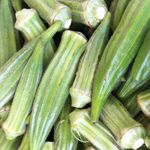|
Ozark Green Thumb BCMG Monthly e-Newsletter |
|
|
 Another casualty in the homogenization of American culture is the loss of our strong regional identity with food. Food used to be grown in the garden and then taken directly to the kitchen. But today, few young families have the time or space for a garden, and even home cooked meals are becoming endangered. Will the next generation even know of traditional southern food? Okra is in high season now, so let's look at how it became a part of our cultural heritage. Okra (Hibiscus esculentus) is a fast growing, heat-loving tropical annual found in the wild along the White Nile, which drains the southwestern highlands of Ethiopia. It's usually unbranched with the trunk reaching 6 to 10 feet tall by the end of the season. Leaves are coarse, palmately-veined and covered with a fine bristly pubescence that many find irritating to their skin. Flowers are cream colored and have the general shape and form of a hibiscus blossom except they do not splay out flat. Like other hibiscus blossoms, they remain open only one day. Some okra selections show a definite photo-period response and produce most of their flowers in late summer as the days begin to get shorter. Okra pods are variable, ranging from the typical kinds to short and fat types built on the model of a Cuban cigar to skinny, foot-long, five-sided affairs. While most are green, some have red-pigmented pods. Regardless of the shape or color, okra pods mature quickly. Depending on temperature, they must be picked within four or five days of blooming. After that, the walls of the pod quickly lignify and they become inedible. Okra is the quintessential southern food, but its origins are a bit murky. It seems to have spread out of Africa to the Middle East and to India by the time of Christ. It was first reported in the New World in Brazil in 1658, probably originating in Africa with early slave trade. Its entry into the United States seems to be in doubt. The most logical and plausible explanation, at least to me, is that it came with the early slaves from western Africa. Okra is thought to be a corruption of "nkru-ma," a name used by the Asante people (tribes from modern day Ghana) for the plant. Some food historians want to give the French-Creoles credit for popularizing the vegetable, known to them as "gumbo." But the name gumbo - a common name used for okra in parts of the Gulf Coast - is also taken from a Bantu word "kigombo," so the Creoles almost certainly learned of the vegetable from slaves. The origin of our southern cuisine is a point of contention amongst scholars who study such things. Attempts to assign provenance to many southern food traditions is sure to cause a heated debate. Written records are scarce, and those that do exist, favor the white slave owners. But this can hardly be considered convincing evidence for slave owners forbid slaves from learning to read and write. Okra is an easy vegetable to grow in any average garden soil. It flowers over a long period, and, as long as the pods continue to be picked, it will keep flowering until the days begin to cool off in the fall. Because it's self-pollinated, seeds can be saved from late season pods. By: Gerald Klingaman, retired
Extension Horticulturist - Ornamentals Extension News - September 2, 2005
0 Comments
Leave a Reply. |
Archives
April 2022
|
|
